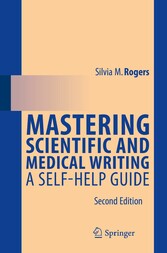Suchen und Finden
Preface
6
About the Author
8
Acknowledgments
10
Contents
12
1: Introduction
16
2: Good Versus Poor Scientific Writing: An Orientation
18
2.1 What Is “Good” Scientific Writing?
18
2.2 The Plain Language Movement
19
2.3 The Baso Pyramid of Scientific Writing
20
2.3.1 Baseline
21
2.3.2 Style
21
2.3.3 Opinion
21
2.4 Common Myths and Misconceptions
22
2.4.1 What Are Myths and Misconceptions?
22
2.4.2 Long and Complicated Sentences
23
2.4.3 Misusing or Wasting Specific and Generic Terms
23
2.4.4 Reluctance to Use First-Person Pronouns Leading to Overuse of Passive Voice
24
2.4.5 Tendency to Turn Sharp and Powerful Verbs into Weighty Nouns
24
3: Words and Units: Orthography and Punctuation
25
3.1 Correct Spelling
25
3.1.1 Getting Words Right
25
3.1.2 Using Spell Checkers
26
3.2 Consistent Spelling: American English Versus British English
26
3.3 Punctuation
27
3.3.1 Proper Use of Punctuation Marks
27
3.3.2 Hyphens and Word Division
27
3.3.3 Punctuation Marks Indicating Emotion
29
3.3.4 Parentheses and Brackets
29
3.3.5 Periods in Titles and Academic Degrees
30
3.3.6 Apostrophes in Contractions
31
3.3.7 Nonbreaking Spaces and Hyphens
31
3.4 Shortened Word Forms in Scientific Writing
32
3.4.1 Types of Abbreviations
32
3.4.2 True Abbreviations
33
3.4.2.1 Latin Abbreviations
33
3.4.3 Units of Measurement
33
3.4.4 Acronyms and Initialisms
35
3.4.5 Contractions
35
3.4.6 Suspensions
36
3.5 Numbers
36
3.5.1 Expressing Numbers in Scientific Texts
36
3.5.2 Formats of Numbers
37
3.5.3 Ranges of Numbers
38
3.5.4 Percentages
38
3.6 Capitalization
39
3.6.1 Use of Capitals in Scientific English
39
3.6.2 Capitals in Proper Nouns (Names)
39
3.6.3 Capitals in Titles
40
3.6.3.1 Capitalizing Hyphenated Compound Words in Titles
40
3.6.4 Capitals in Designations
41
3.6.5 Capitals in New-Age Words
41
4: Forming Sentences: Grammar
42
4.1 Why Battle with Grammar?
42
4.2 The Tenses in Scientific Reporting
43
4.3 Joining Statements
45
4.3.1 How Can the Joining of Words or Statements Cause Confusion?
45
4.3.2 Nonparallel Verbs
46
4.3.3 Nonparallel Modifiers
47
4.3.4 Nonparallel Prepositional Phrases
48
4.4 Subject–Verb Agreement
48
4.4.1 Using the Correct Verb Forms
48
4.4.2 Special Nouns
50
4.4.3 Collective Nouns
50
4.4.4 The Rule of Meaning
51
4.4.5 Verb Matching with “None” and the “Neither–Nor” Linkage
52
4.5 Syntax (Order of Words)
53
4.5.1 Modifying Phrases
53
4.5.2 Position of Adverbs in Sentences
54
4.5.3 Position of Prepositions in Sentences
55
4.6 Dangling Participles (and Other Danglers)
56
4.6.1 What Are Danglers?
56
4.6.2 Dangling Participles
56
4.6.3 Dangling Gerunds
58
4.7 The Relative Pronouns “Which” and “That”
58
4.8 Use of “Respectively”
59
4.9 Plurals of Abstractions and Attributes
60
5: Putting It Nicely: Style
61
5.1 What Is “Style” in the Context of Scientific Writing?
61
5.2 Active Versus Passive Voice
62
5.2.1 Why Argue About Active/Passive Voice?
62
5.2.2 Shifting Emphasis by Choosing the Voice
62
5.2.3 The Verb “To Be” in Copula Formulations
63
5.3 Overuse of Prepositions
63
5.4 Limiting Modifiers and Other Decorative Words
65
5.4.1 Excessive Adjectives, Adverbs, and Nouns
65
5.4.2 Modifier Strings
66
5.5 The “House Style” of Journals
67
5.6 Company-Internal Conventions of Style and Format
68
6: Redundancy and Jargon: Focusing on the Essentials
70
6.1 Redundancies in Scientific Reporting
70
6.2 Double Negatives
71
6.3 Tautology (Repeated and Redundant Words)
71
6.4 Doubling Prepositions
72
6.5 Jargonized Writing
73
6.6 Oxymorons
74
7: Quoting Published Material: Reference Formats
75
7.1 What Can Go Wrong When Quoting Published Material?
75
7.2 Reference Formats and the Uniform Requirements
76
7.2.1 What Style Should I Use?
76
7.2.2 Using Vancouver Style
76
7.2.3 Reference Manager Tools
79
8: Ethics of Scientific Writing: Avoiding Discrimination
80
8.1 Prejudice and Semantic Labeling
80
8.2 Sexist Writing and Gender-Biased Expressions
80
8.2.1 Sex Versus Gender
80
8.2.2 Gender-Inclusive Language
81
8.3 Racist Writing
82
8.4 Ageism
83
9: Sticking to Your Word: Avoiding Plagiarism
84
9.1 What Is Plagiarism?
84
9.2 Forms of Plagiarism
85
9.2.1 Plagiarism of Text
85
9.2.2 Plagiarism of Ideas
86
9.2.3 Self-Plagiarism
87
9.3 How to Avoid Plagiarism
88
10: Structuring Scientific Texts: Getting the “Story” out
90
10.1 Determining the Audience
90
10.2 Adapting the “Story” to the Readers’ Needs
91
10.3 Drafting an Abstract
92
10.3.1 The Importance of Abstracts
92
10.3.2 Descriptive Abstracts
93
10.3.3 Informative Abstracts
93
10.3.4 Structured Abstracts
93
11: Appendix
94
11.1 Scientific Writing Rules at a Glance
94
11.2 American English Versus British English: Groups of Words Affected by the Different Spelling
97
11.3 The Main Punctuation Marks in Scientific Writing
98
11.4 Awkward Phrases to Avoid
100
11.5 List of Academic Degrees and Honors
103
12: Exercises
106
12.1 Exercise 1 | Consistent Spelling
106
12.2 Exercise 2 | Proper Punctuation
106
12.3 Exercise 3 | Using Numbers and Percentages Correctly
107
12.4 Exercise 4 | Using Proper Capitalization
108
12.5 Exercise 5 | Using Tenses in Scientific Reporting
108
12.6 Exercise 6 | Restoring Parallelism
109
12.7 Exercise 7 | Avoiding Verbal Phrase Danglers
110
12.8 Exercise 8 | Using “Respectively” Properly
110
12.9 Exercise 9 | Avoiding Excessive Passive Voice
111
12.10 Exercise 10 | Limiting the Number of Prepositions
111
12.11 Exercise 11 | Using Modifiers in Moderation
112
12.12 Exercise 12 | Avoiding Tautological and Other Redundant Expressions
112
13: Solutions to Exercises
113
13.1 Solutions to Exercise 1
113
13.2 Solutions to Exercise 2
114
13.3 Solutions to Exercise 3
115
13.4 Solutions to Exercise 4
115
13.5 Solutions to Exercise 5
116
13.6 Solutions to Exercise 6
117
13.7 Solutions to Exercise 7
118
13.8 Solutions to Exercise 8
118
13.9 Solutions to Exercise 9
119
13.10 Solutions to Exercise 10
120
13.11 Solutions to Exercise 11
120
13.12 Solutions to Exercise 12
120
References
122
Dictionaries
122
Selected Books
122
Published Literature
123
Alle Preise verstehen sich inklusive der gesetzlichen MwSt.













